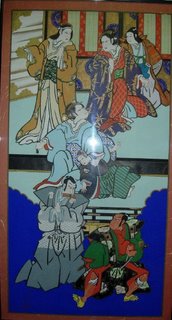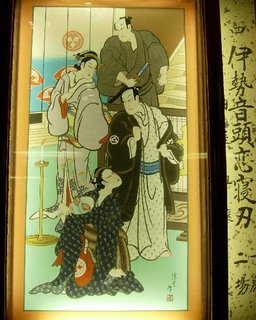Friday night, Adriaan and me, went to the Kabuki-za Theatre in Tokyo.

This is Japanese theatre where the masculine "rough style" is typified by exaggerated movement, makeup, costume and diction. During the Edo Period Kabuki came into existence and reached its peak. The Edo Period (1603 - 1868) was an era of peace and of isolation from the rest of the world. The latter the policy of the ruling Tokuwaga family which provided fifteen generations of shoguns or military dictators. Tokugawa officials banned women from the stage in 1629. Since that time, kabuki has been performed exclusively by men, giving rise to the institution of "onnagata/oyama" male actors who specialise in female roles.

The popular themes are about famous historical accounts and stories of love-suicide. The acting is a combination of dancing and speaking in conventionalised intonation patterns ( sometimes so high-pitched). Kabuki actors are born to the art form, and training begins in childhood.

We saw the "Ise ondo koi no netaba" (the killings at Ise). This play is famous for its classical depiction of a woman who must pretend to reject her lover for his sake and for the beautiful and gruesome dance-like killing scene with a famous sword at the end.
So, you can imagine what love story this is. Then they use also this Japanese string instrument, "Koto", playing one note at a time and tap with blocks during the play when there is tension (or perhaps to wake up the viewers).

The decor was also beautiful and they wore wonderful colorful clothes.

This is Japanese theatre where the masculine "rough style" is typified by exaggerated movement, makeup, costume and diction. During the Edo Period Kabuki came into existence and reached its peak. The Edo Period (1603 - 1868) was an era of peace and of isolation from the rest of the world. The latter the policy of the ruling Tokuwaga family which provided fifteen generations of shoguns or military dictators. Tokugawa officials banned women from the stage in 1629. Since that time, kabuki has been performed exclusively by men, giving rise to the institution of "onnagata/oyama" male actors who specialise in female roles.

The popular themes are about famous historical accounts and stories of love-suicide. The acting is a combination of dancing and speaking in conventionalised intonation patterns ( sometimes so high-pitched). Kabuki actors are born to the art form, and training begins in childhood.

We saw the "Ise ondo koi no netaba" (the killings at Ise). This play is famous for its classical depiction of a woman who must pretend to reject her lover for his sake and for the beautiful and gruesome dance-like killing scene with a famous sword at the end.
So, you can imagine what love story this is. Then they use also this Japanese string instrument, "Koto", playing one note at a time and tap with blocks during the play when there is tension (or perhaps to wake up the viewers).

The decor was also beautiful and they wore wonderful colorful clothes.


0 Comments:
Post a Comment
<< Home